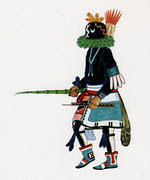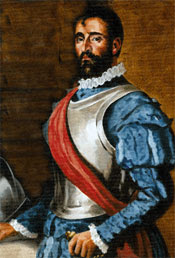 Photo of "Estebanico el Negro" by the sculptor, John Houser, courtesy of Borderlands, El Paso Community College Local History Project
Photo of "Estebanico el Negro" by the sculptor, John Houser, courtesy of Borderlands, El Paso Community College Local History ProjectAnother one of the four, the Moroccan-born Estebán (variously known as Estebanico el Negro, Estebán de Dorantes, Little Stephen, Black Stephen, and Stephen the Moor) has his own interesting history.
I had planned a post about Estebán when I finished the Cabeza de Vaca post. Only a few days after that post, I happened to see the movie National Treasure 2: Book of Secrets. I had decided to see the movie after reading in Rick Beyer's history blog about the accuracy and detail of the many historical references in the movie. (Click here to read the details.)
So imagine my surprise to find that Estebán (and by implication--though not by name--Cabeza de Vaca) were also featured in the movie, which theorizes that the city of Cíbola, as visited by Estebán, still exists in the US (though there is no evidence that Estebán ever traveled further north than New Mexico).
Estebán was born in Morocco ca. 1503, and sold into slavery to Andres de Dorantes during a devastating drought and famine in his native country in 1520-21. Dorantes treated him well, and Estebán proved himself a smart, strong, and trustworthy servant. When Dorantes joined Narváez's expedition, he brought Estebán along. During their travels through Indian country in Texas, Estebán demonstrated exceptional language and relationship skills, learning numerous Indian dialects, and impressing the natives as a friendly, trustworthy giant. Because the group were also seen as powerful medicine men, Estebán was also the recipient of two sacred gourds and an engraved copper medicine rattle from the Arbadaos tribe in Texas.
 When the travelers arrived in Mexico City in 1536, Estebán became a well-known figure about town. He liked to adorn his arms and legs with bright bells and feathers, and had acquired two handsome greyhounds who accompanied him.
When the travelers arrived in Mexico City in 1536, Estebán became a well-known figure about town. He liked to adorn his arms and legs with bright bells and feathers, and had acquired two handsome greyhounds who accompanied him.The Viceroy of Mexico bought Estebán from Dorantes, and appointed him as guide and interpreter to an expedition seeking the "Seven Cities of Cíbola" (or the "Seven Cities of Gold"). The myth/rumors/legend about these fabulous cities had existed since the 12th century in Spain, and had been fueled by the accounts of Cabeza de Vaca and his companions of the pueblo cities they had seen and heard about.
 The priest Fray Marcos de Niza was put in charge of the expedition which departed Mexico City in 1539. Estebán went on ahead of de Niza, and sent his own advance runner, carrying his special gourds and rattle, to announce his coming.
The priest Fray Marcos de Niza was put in charge of the expedition which departed Mexico City in 1539. Estebán went on ahead of de Niza, and sent his own advance runner, carrying his special gourds and rattle, to announce his coming. When Estebán reached the first Zuni pueblo in New Mexico (believed to be the pueblo of Hawikuh), he believed that he had found the cities of gold (or at least that was the word he sent back to de Niza). Some have theorized that the straw mixed in the adobe glittered like gold in the clear mountain air and strong sunlight (or glowing sunset light) of New Mexico.
But Estebán was not as well received by the Zunis as he had been by tribes throughout his journeys. They may have mistrusted his symbols (unfamiliar medicine rattles), or resented his demands for turquoise and women, or been angered by his crossing a sacred cornmeal line during a tribal ceremony. Perhaps it was a combination of all three.
In any case, he and his companions were arrested and kept in a small hut near the pueblo for several days while the Zuni council members debated what to do. In the end, Estebán was killed by arrow fire.
But he lives on in history in a variety of ways: in the figure of a black giant/monster/ogre Zuni kachina named Chakwaina, as a historical black figure (the first black man in America), and in the vision of contemporary artists like John Houser of El Paso, who created the bronze shown above, or Duane Dishta, a Zuni artist, whose images of Chakwaina are also shown here.











